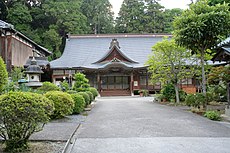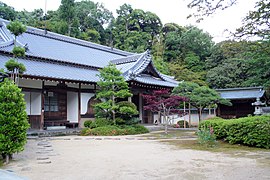Kōmyō-ji (Katō)
The Kōmyō-ji ( Japanese 光明 寺 ) with the mountain name Gobu-san ( 五峯山 ) is a temple of the Kōyasan branch ( 高 野山 派 ) of the Shingon direction of Buddhism in Katō ( Hyōgo Prefecture ). It is the 28th temple on the New Saigoku Pilgrimage Route .
history
According to tradition, the temple was built in 594 by the priest Hōdō ( 法 道 仙人 Hōdō sennin ). Later, at the request of Emperor Nimmyo, the temple complex was expanded. The battle of the Ashikaga regent Takauji with his younger brother Tadayoshi took place at this temple in 1352. In 1485, a battle between Akamatsu Masanori ( 赤松 政 則 ; 1455–1496) and the Yamana took place at the temple , from which Masanori proceeded victoriously. He was able to restore the lost power over Harima .
The temple was occasionally ravaged by fires, the current buildings date from the Edo period and after.
investment
If you climb up from the valley to the temple, you pass the sub-temples ( 塔 頭 寺院 Tatchū jiin ), namely the Tamon-in ( 多 聞 院 ), Henjō-in ( 遍照 院 ) and Daiji-in ( 大 慈院 ) and then reach the temple gate ( 山門 Sanmon ), which is designed here as a Niō gate ( 仁王 門 Niō-mon ), i.e. as a gate with the two temple guards to the right and left of the passage.
The Jōgyō Hall ( 常 行 堂 Jōgyō-dō ) was originally built by priest Jikaku Daishi ( 慈 覚 大師 ), i.e. Ennin . The current main hall ( 本 堂 Hondō ) was built in 1925 by the architect Takeda Goichi (1872-1938) in place of the hall that burned down in 1860. It is 9 × 9 Ken in size, has a hipped foot roof with a canopy and is covered with sheet copper. Other buildings include the Monju Pavilion ( 文殊 堂 ) from 1682, the Jōgyō Hall ( 常 行 堂 ), which was rebuilt from 1701 to 1702, the bell tower ( 鐘楼 Shōrō ) and the stone stupa known as "Hōkyōintō" ( 宝 筐 印 塔 ) from 1689.
Temple treasures
The only hanging scroll with the image of the priest Shandao ( 善導大師 ; 616–683) in Japan is kept in the Daiji-in . From the original three self-portrayals Ennin took one back with him, one was given to the temple by the student Enshin ( 円 心 ) in 847. The picture is open to the public on May 3rd each year during the Cherry Blossom Festival.
The Henjō-in has a seated Buddha figure ( 銅像 如 来 坐像 Dōzō nyorai zazō ) made of bronze. The figure is 24.2 cm high, has a large head and a well-formed chest. The narrow eyebrows arch over long, narrow eyes, the mouth is relatively small. This Buddha figure is assigned to the early Heian period and is registered as an important cultural asset of Japan .
photos
literature
- Hyōgo-ken no rekishi sampo henshu iinkai (ed.): Komyoji . In: Hyogo-ken no rekishi sampo (ge). Yamakawa Shuppan, 2012. ISBN 978-4-634-24828-1 . Pp. 64 to 65.
Web links
Coordinates: 34 ° 56 ′ 54.7 ″ N , 134 ° 56 ′ 50.1 ″ E





